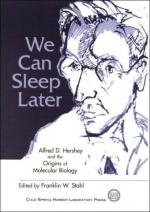|
This section contains 1,416 words (approx. 5 pages at 300 words per page) |

|
World of Microbiology and Immunology on Alfred Day Hershey
By seeking to understand the reproduction of viruses, Alfred Day Hershey made important discoveries about the nature of deoxyribonucleic acid (DNA) and laid the groundwork for modern molecular genetics. Highly regarded as an experimental scientist, Hershey is perhaps best known for the 1952 "blender experiment" that he and Martha Chase conducted to demonstrate that DNA, not protein, was the genetic material of life. This discovery stimulated further research into DNA, including the discovery by James Watson and Francis Crick of the double-helix structure of DNA the following year. Hershey's work with bacteriophages, the viruses that prey on bacteria, was often carried out in loose collaboration with other scientists working with bacteriophages. Hershey shared the Nobel Prize in Physiology or Medicine in 1969 with Max Delbrück and Salvador Edward Luria. The Nobel Committee praised the three scientists for their contributions to molecular biology. Their basic research into viruses also...
|
This section contains 1,416 words (approx. 5 pages at 300 words per page) |

|


